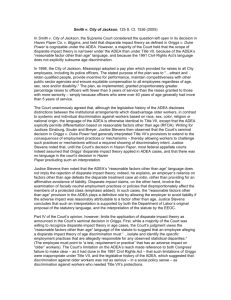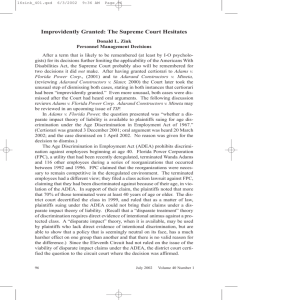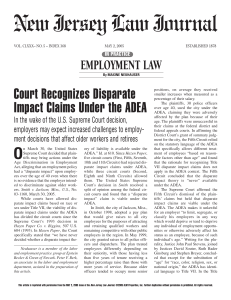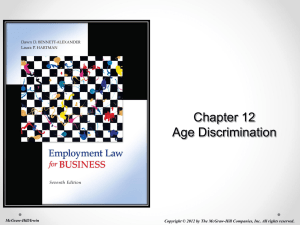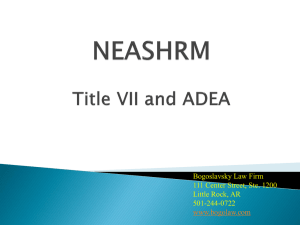Disparate Impact under the Age Discrimination in Employment Act of
advertisement
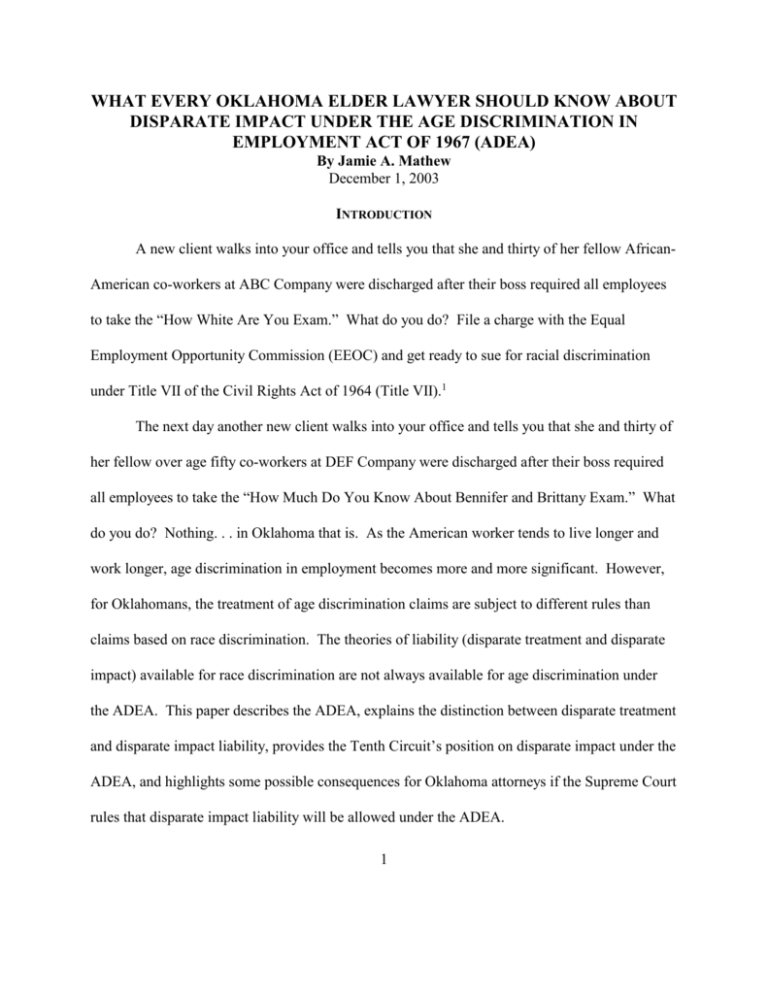
WHAT EVERY OKLAHOMA ELDER LAWYER SHOULD KNOW ABOUT DISPARATE IMPACT UNDER THE AGE DISCRIMINATION IN EMPLOYMENT ACT OF 1967 (ADEA) By Jamie A. Mathew December 1, 2003 INTRODUCTION A new client walks into your office and tells you that she and thirty of her fellow AfricanAmerican co-workers at ABC Company were discharged after their boss required all employees to take the “How White Are You Exam.” What do you do? File a charge with the Equal Employment Opportunity Commission (EEOC) and get ready to sue for racial discrimination under Title VII of the Civil Rights Act of 1964 (Title VII).1 The next day another new client walks into your office and tells you that she and thirty of her fellow over age fifty co-workers at DEF Company were discharged after their boss required all employees to take the “How Much Do You Know About Bennifer and Brittany Exam.” What do you do? Nothing. . . in Oklahoma that is. As the American worker tends to live longer and work longer, age discrimination in employment becomes more and more significant. However, for Oklahomans, the treatment of age discrimination claims are subject to different rules than claims based on race discrimination. The theories of liability (disparate treatment and disparate impact) available for race discrimination are not always available for age discrimination under the ADEA. This paper describes the ADEA, explains the distinction between disparate treatment and disparate impact liability, provides the Tenth Circuit’s position on disparate impact under the ADEA, and highlights some possible consequences for Oklahoma attorneys if the Supreme Court rules that disparate impact liability will be allowed under the ADEA. 1 DESCRIPTION OF THE ADEA The Age Discrimination in Employment Act of 1967 (ADEA) is a federal statute passed to encourage the employment of older workers based on their capabilities instead of their age, to proscribe capricious employment discrimination based on age, and to assist employers and employees in addressing employment problems affected by age.2 The ADEA was passed in the same era as legislation prohibiting racial, religious, and gender discrimination.3 Interestingly, Title VII of the Civil Rights Act of 1964 does not cover age discrimination. Instead, age discrimination is addressed in its own right under the ADEA, first enacted in 1967. Congress targeted age discrimination under the ADEA because it found that older employees were disadvantaged in retaining and regaining employment, that older workers were limited by capricious age limits, that older workers were particularly harmed by unemployment, and that these problems ultimately burdened the American economy.4 The ADEA applies to employers, employment agencies, and labor organizations.5 Although the ADEA originally only applied to workers who were age forty to sixty-five,6 today the ADEA applies to those workers who are forty years old or older.7 The ADEA makes it illegal for employers to commit age discrimination in hiring and firing employees, in “compensation, terms, conditions, or privileges,” in adversely affecting an employee’s status, or in reducing pay to comply with the ADEA.8 The ADEA prohibits employers, employment agencies, and labor organizations from retaliating against employees who have assisted or taken action under the ADEA.9 However, under the ADEA an employer, employment agency, or labor organization may act in a way that ordinarily would violate the 2 ADEA, if “age is a bona fide occupational qualification reasonably necessary to the normal operation of the particular business, or where the differentiation is based on reasonable factors other than age. . . .”10 The ADEA also requires employers, employment agencies, and labor organizations to post notices to inform employees of their rights under the ADEA.11 Before an attorney commences a civil claim under the ADEA, the client must file a charge of illegal discrimination with the Equal Employment Opportunity Commission (EEOC).12 Normally, the EEOC charge must be filed “within 180 days after” the illegal occurrence.13 In court, the employee is entitled to a jury trial.14 If the employee prevails under the ADEA, she may be entitled to “unpaid wages, reinstatement, promotion, [and] liquidated damages.”15 Prevailing employees may also be entitled to attorney fees.16 One might pursue alternative claims under ERISA, Title VII, The Equal Pay Act, or certain state acts, depending on the exact circumstances of the client.17 THE DIFFERENCE BETWEEN DISPARATE TREATMENT AND DISPARATE IMPACT There are two possible theories of liability under the ADEA: disparate treatment and disparate impact. Disparate treatment cases are those in which the employee is treated disfavorably because of her protected status.18 Under disparate treatment claims the claimant must prove discriminatory intent.19 For instance, if an accountant were to discharge a fifty-fiveyear-old secretary because the accountant believes the secretary is now too old, then such conduct would constitute a cause of action under disparate treatment liability. 3 Alternatively, disparate impact occurs when an employer implements a facially neutral policy, which happens to have adverse consequences for employees in a protected class, and the employer lacks a valid business necessity justification for doing so.20 For example, if a bank manager instituted a requirement for all of the bank tellers to pass an exam, completely unrelated to banking, in order to retain their jobs, and only people under the age of forty could pass the exam, that would create a cause of action under disparate impact liability. THE TENTH CIRCUIT ONLY ALLOWS DISPARATE TREATMENT CLAIMS UNDER THE ADEA In Ellis v. United Airlines, Inc.,21 United Airlines failed to hire two experienced flight attendants because the flight attendants did not pass the airline’s new flight attendant weight requirements. Even though the flight attendants were previously employed by Frontier airlines, at age forty and thirty-eight the flight attendants did not meet the weight requirements of 134 pounds and 139 pounds, respectively. United based the maximum weight allowed for new flight attendants on height alone and did not account for weight gain in relation to age.22 The flight attendants sued United Airlines, claiming that the refusal to hire them was a violation of the ADEA. One theory the flight attendants relied upon was that the weight requirements were in violation of the ADEA because the requirements had a disparate impact on them because they were older.23 This argument was rejected. The Court of Appeals for the Tenth Circuit held that the flight attendants did not have a cause of action under the ADEA because the ADEA does not allow claims based on disparate impact liability.24 4 The Tenth Circuit gave four reasons for its holding. First, the Tenth Circuit based its reasoning on the language of the ADEA.25 The Tenth Circuit reasoned that the “because of such individual’s age” language in the ADEA would more rationally proscribe only intentional discrimination and not “incidental and unintentional discrimination that resulted because of employment decisions which were made for reasons other than age.”26 Further, the exception in ADEA Section 623(f) that allows employers, employment agencies, and labor organizations to perform otherwise unlawful conduct is more like the Equal Pay Act, which disallows disparate impact claims, than Title VII, which allows disparate impact claims.27 Second, the Tenth Circuit based its reasoning on the legislative history of the ADEA.28 The Tenth Circuit reasoned that the Older American Worker: Age Discrimination in Employment report by the Secretary of Labor and the purposes and findings of the ADEA suggested that disparate treatment and disparate impact discrimination be treated differently for age discrimination.29 Third, the Tenth Circuit relied on Congress’ inaction.30 Title VII was amended to include disparate impact, but the ADEA was not.31 The Tenth Circuit deduced that Congress did not intend to allow disparate impact claims under the ADEA.32 Fourth, the Tenth Circuit interpreted the Supreme Court’s dicta in Hazen to disallow disparate impact liability under the ADEA.33 Although the Tenth Circuit admitted that Hazen was a disparate treatment case, the analysis used by the Supreme Court was suggestive of the Court’s leaning toward only disparate treatment claims under the ADEA.34 These four rationales have settled the issue for Oklahoma lawyers in the Tenth Circuit. Of course, the Supreme Court has the power to overrule the Tenth Circuit’s position and allow disparate impact liability, but so far it has not done so. 5 OKLAHOMA LAWYERS SHOULD BE WARY: THE SUPREME COURT COULD MANDATE DISPARATE IMPACT CLAIMS UNDER THE ADEA The federal circuit courts are split on the issue of whether disparate impact liability is allowed under the ADEA.35 Although the issue is settled in the Tenth Circuit, the Ellis ruling could be overruled if the Supreme Court decides otherwise. In 1993, the Supreme Court in Hazen explicitly stated that it was not deciding whether the ADEA allowed disparate impact claims and that the decision made in Hazen did not constitute a decision on the disparate impact issue.36 The Court recently granted certiorari in one case regarding the disparate impact issue but then dismissed that case.37 The Court may well decide to take up this issue again. In 2001, the Eleventh Circuit ruled that disparate impact was not available under the ADEA in Adams v. Florida Power Corp.38 In Adams, a group of employees were discharged during several reorganizations of the Florida Power Corporation. The Florida Power Corporation was attempting to remain competitive in the utility market after Congress passed the Energy Policy Act of 1992, which deregulated the energy market and made it more competitive. The employees brought a class action ADEA suit against Florida Power Corporation and Florida Progress Corporation.39 The district court ruled that disparate impact liability was unavailable under the ADEA as a matter of law.40 The Eleventh Circuit affirmed.41 The Supreme Court granted certiorari to the Eleventh Circuit.42 The Court heard oral arguments for the case on March 20, 2002.43 However, on April 1, 2002, the Court dismissed certiorari “as improvidently granted.”44 The Court did not express any reasons for dismissing certiorari.45 However, because 6 the case was not decided, the possibility still remains that the Court will eventually decide that disparate impact claims are cognizable under the ADEA. If the Court does rule in favor of disparate impact claims under the ADEA, Oklahoma lawyers will have another theory of employer liability available to them. But this opportunity will come with its own special costs and responsibilities. Oklahoma lawyers may have to become more proficient with statistical evidence in the age discrimination context. The statistical analysis for age discrimination can be more complicated than in other kinds of discrimination cases, because in ADEA cases the plaintiff need not prove that someone outside the protected class (of forty year old or older persons) was hired in her place, only that someone younger than the plaintiff was hired in her place.46 Theoretically, it could be easier to construct a prima facie case for age discrimination, especially in class action suits, if the Court allows disparate impact claims under the ADEA, because statistical evidence would only need to prove that the replacement employees were younger than the plaintiffs, instead of having to prove either that the replacement employees were younger than forty under disparate impact theory, or that there was an intent to discriminate under disparate treatment theory. CONCLUSION Oklahoma lawyers currently only have the disparate treatment theory of liability available to them under the ADEA. Although this is settled law in the Tenth Circuit, the Supreme Court may yet rule that disparate impact liability is available under the ADEA. The consequences of that decision would give Oklahoma lawyers an additional theory for ADEA cases and would 7 provide an opportunity to test different types of statistical evidence under disparate impact theory. 1 See Civil Rights Act of 1964, 42 U.S.C. §§ 2000e et. seq. (2002). Age Discrimination in Employment Act of 1967, 29 U.S.C. § 621 (2002). Full text of the ADEA may be found at <http://www.eeoc.gov/policy/adea.html >. 3 H.R. REP. NO. 90-805 (1967), reprinted in 1967 U.S.C.C.A.N. 2213, 2214. 4 29 U.S.C. § 621 (2002). 5 29 U.S.C. § 623 (2002). 6 Age Discrimination in Employment Act of 1967, Pub. L. No 90-202, § 12, 81 Stat. 602, 607 (1967). 7 29 U.S.C. § 631(a) (2002). 8 29 U.S.C. § 623(a) (2002). 9 29 U.S.C. § 623(d) (2002). 10 29 U.S.C. § 623(f) (2002). 11 29 U.S.C. § 627 (2002). 12 29 U.S.C. § 626(d) (2002). 13 29 U.S.C. § 626(d)(1) (2002); e.g. The U.S. Equal Employment Opportunity Commission, Filing a Charge, available at <http://www.eeoc.gov/facts/howtofil.html> (last viewed October 27, 2003). 14 29 U.S.C. § 626(c)(2). 15 Rene E. Thorne & Howard Shapiro, The Age Discrimination in Employment Act: Protection for Older Workers, 15 No. 2 COMPLEAT LAW 36, 39 (1998); See e.g. The U.S. Equal Employment Opportunity Commission, Federal Laws Prohibiting Job Discrimination Questions and Answers, available at <http://www.eeoc.gov/facts/qanda.html> (last viewed October 27, 2003). 16 Id. 17 See The U.S. Equal Employment Opportunity Commission, Federal Laws Prohibiting Job Discrimination Questions and Answers, available at <http://www.eeoc.gov/facts/qanda.html> (last viewed October 27, 2003). 18 Hazen Paper Co. v. Biggins, 507 U.S. 604, 608 (1993). 19 Id. at 608. 20 Id. 21 Ellis v. United Airlines, 73 F.3d 999 (10th Cir. 1996). 22 Id. at 1001. 23 Id. at 1000. 24 Id. at 1001. 25 Id. at 1007. 26 Id. (citing Hazen, 507 U.S. at 611-13). 27 Ellis, supra note 21, at 1007-08. 28 Id. at 1008. 29 Id. 30 Id. 31 Id. 32 Ellis, supra note 21, at 1008. 33 Id. at 1008-09. 34 Id. at 1009. 35 Adams v. Florida Power Corp., 255 F.3d 1322, 1326 (11 th Cir. 2001) (citing Criley v. Delta Air Lines, Inc., 119 F.3d 102, 105 (2d Cir. 1997) (per curiam); Lewis v. Aerospace Cmty. Credit Union, 114 F.3d 745, 750 (8 th Cir. 1997); Frank v. United Airlines, Inc., 216 F.3d 845, 856 (9 th Circuit 2000); E.E.O.C. v. Local 350, 998 F.2d 641 n.2 2 8 (9th Cir. 1993) in favor of disparate impact theory and citing Mullin v. Raytheon Co., 164 F.3d 696, 700-01 (1st Cir.) cert. denied, 528 U.S. 811 (1999); E.E.O.C. v. Francis W. Parker School, 41 F.3d 1073, 1076-77 (7th Cir. 1994); Ellis, 73 F.3d at 1006-07; DiBiase v. SmithKline Beecham Corp., 48 F.3d 719, 732 (3d Cir. 1995); Lyon v. Ohio Educ. Ass’n and Prof’l Staff Union, 53 F.3d 135, 139 n.5 (6 th Cir. 1995) questioning disparate impact). 36 Biggins, supra note 18, at 610. 37 See Adams v. Florida Power Corp., 535 U.S. 228 (2002). 38 Id. at 1326. 39 Id. at 1323. 40 Id. 41 Id. 42 Id. at 1054. 43 See Transcript of Oral Argument in Adams v. Florida Power Corp., (No. 01-584) (March 20, 2002). 44 Adams, supra note 37, at 228. 45 Id. 46 See O’Connor v. Consolidated Coin Caterers Corp., 517 U.S. 308, 312 (1996). 9
